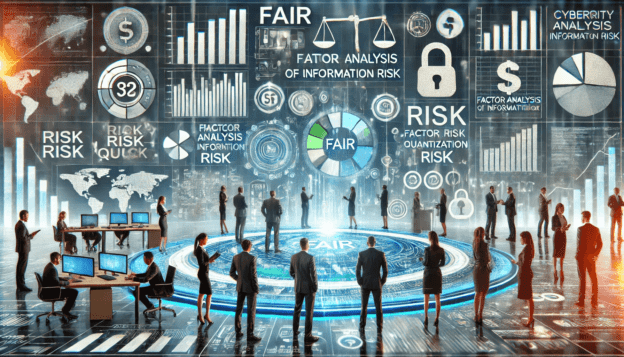The Factor Analysis of Information Risk (FAIR) framework has emerged as a cornerstone in cyber risk quantification, enabling organisations to measure and communicate risk in financial terms. FAIR’s evolution represents a shift from traditional qualitative assessments to a structured, quantitative model that aligns cybersecurity strategies with business objectives. By breaking down risk into probability and impact components, FAIR provides decision-makers with actionable insights to prioritise investments and mitigate threats effectively.
This article explores the origins, principles, evolution, and modern applications of FAIR, demonstrating its value as a tool for translating technical risks into financial language.
Contents
1. The Origins of FAIR
FAIR was introduced in the early 2000s by Jack Jones, a cybersecurity professional seeking to standardise how organisations assess and communicate cyber risk. Dissatisfied with the industry’s reliance on vague metrics and subjective interpretations, Jones developed FAIR as a methodology grounded in data and mathematics.
Key motivations for FAIR’s development:
- Clarity: Create a consistent, repeatable way to define and assess risk.
- Actionability: Translate risk into financial terms that resonate with business leaders.
- Standardisation: Establish a common language for risk management across industries.
In 2014, FAIR was adopted by the Open Group, a global consortium, and became the foundation of the Open FAIR Certification Program, solidifying its role as a global standard.
2. How FAIR Works
FAIR is a quantitative model that breaks risk into two core components:
- Loss Event Frequency (LEF): The likelihood of a specific event occurring.
- Loss Magnitude (LM): The potential financial impact of the event.
These components are further divided into subcategories:
Loss Event Frequency (LEF)
- Threat Event Frequency (TEF): How often a threat attempts to exploit a vulnerability.
- Vulnerability: The probability that the threat will succeed if attempted.
Loss Magnitude (LM)
- Primary Loss: Direct costs, such as data recovery, fines, or operational downtime.
- Secondary Loss: Indirect costs, such as reputational damage, customer churn, or regulatory penalties.
FAIR uses these variables to calculate risk in monetary terms, enabling organisations to understand the financial implications of cyber threats.
3. The Evolution of FAIR
FAIR has evolved significantly since its inception, driven by advancements in technology, data availability, and organisational needs.
Key Milestones
- Integration with Data Analytics (2010s): The rise of big data allowed FAIR to incorporate real-time threat intelligence, improving the accuracy of loss event predictions.
- Adoption by Enterprises: Large organisations, particularly in finance and healthcare, began using FAIR to align cybersecurity with enterprise risk management.
- Regulatory Alignment: FAIR has been adopted as a tool to demonstrate compliance with regulations like GDPR, PCI DSS, and the Digital Operational Resilience Act (DORA).
- Tool Ecosystem: The emergence of FAIR-based software solutions, such as RiskLens, has made FAIR more accessible and scalable for organisations of all sizes.
FAIR’s Expanding Influence
FAIR is no longer limited to cybersecurity; its principles are now being applied to broader risk management scenarios, such as operational resilience and supply chain risks.
4. Modern Applications of FAIR
FAIR is used across industries to quantify and manage cyber risk effectively. Common applications include:
Prioritising Investments
- Example: An organisation evaluates two risks: a ransomware attack on its production servers and a phishing vulnerability. FAIR quantifies the potential financial loss of the ransomware attack at £2M and the phishing vulnerability at £200K, enabling the organisation to prioritise server protection.
Executive Reporting
- FAIR simplifies complex risks into financial figures, making them accessible to boards and executives.
- Example: A CFO uses FAIR to present a £5M risk exposure from unpatched vulnerabilities, justifying a £500K investment in patch management systems.
Cyber Insurance
- FAIR helps insurers calculate premiums based on the likelihood and impact of cyber incidents.
- Example: An insurer uses FAIR to assess a client’s risk of data breaches, factoring in the client’s vulnerability levels and the value of their data assets.
5. Advantages of FAIR
FAIR has gained widespread adoption due to its unique benefits:
- Business Alignment: Translates technical risks into financial language that resonates with executives.
- Objectivity: Provides a consistent, data-driven methodology for assessing risk.
- Flexibility: Can be applied to a wide range of industries and risk scenarios.
- Regulatory Relevance: Supports compliance by providing a robust framework for quantifying and reporting risks.
6. Challenges and Criticisms
Despite its strengths, FAIR is not without challenges:
- Data Requirements: Accurate risk quantification depends on high-quality data, which may not always be available.
- Complexity: Implementing FAIR requires training and expertise, which can be a barrier for smaller organisations.
- Subjectivity in Variables: Some inputs, such as loss magnitude estimates, involve subjective judgment, which can affect consistency.
7. The Future of FAIR
FAIR continues to evolve as organisations demand more precise and actionable risk management tools. Future developments may include:
- AI and Machine Learning Integration: Automating the identification and analysis of variables, such as threat event frequency.
- Expanded Use Cases: Applying FAIR to emerging risks, such as AI-driven cyberattacks or climate-related operational disruptions.
- Broader Adoption: Increased regulatory endorsement may drive FAIR’s adoption in sectors like critical infrastructure and public policy.
Conclusion
FAIR represents a paradigm shift in how organisations approach cyber risk quantification. By breaking down risk into measurable components, FAIR enables decision-makers to align cybersecurity strategies with financial priorities and regulatory requirements. As technology advances and threats become more complex, FAIR’s emphasis on clarity, standardisation, and actionable insights will remain a cornerstone of effective risk management.
